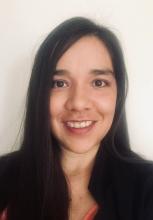Speaker: Rosa María Vargas-Magaña, Universidad Nacional Autónoma de México
Date: November 18, 2021
Title: Undular bores governed by the full water wave equations and bi-directional Whitham-Boussinesq equations
Abstract: The Dispersive Shock Fitting method, initially formulated by G. El and collaborators and later generalized to many other systems, has been applied with great success to study dispersive shock waves (DSWs) in large a variety of settings. DSWs are a generic type of wave arising as solutions of nonlinear dispersive wave equations that consist of two edges, the harmonic wave edge and solitary wave edge propagating with different speeds, with a modulated dispersive wavetrain between these. Until recently, however, most studies were limited to weakly non-linear systems. This talk aims to present our recent analytical and numerical results on DSW solutions, also termed undular bores in fluid mechanics terminology, in the context of the fully nonlinear water wave equations and four weakly nonlinear approximations to the water wave equations, including Boussinesq-type models and Whitham-Boussinesq-type models. This is joint work with Prof. Noel Smyth of the University of Edinburgh and Prof. Tim Marchant of the University of Melbourne. It is found that the Whitham-Boussinesq systems give solutions in near perfect agreement with numerical solutions of the water wave equations for the positions of the leading and trailing edges of the bore up until the onset of modulational instability.
In this talk, I will introduce the KdV-type dispersive shock waves solutions that arise from the weakly nonlinear water wave models that we are studying and talk about the applicability of the Dispersive Shock Fitting method to these systems. I will also discuss the richness of the Whitham-Boussinesq models and the main findings around these systems in recent years. I will then present water wave undular bores obtained by numerically integrating the Hamiltonian Formulation of the Euler equations for a free surface, irrotational flow. And finally, I will summarise all the analytical and numerical findings to show how the Whitham-Boussinesq-type models, which are far simpler than the full water wave equations, can then be used to accurately model surface water wave undular bores. This investigation has opened further research questions that I will also discuss in this talk.
